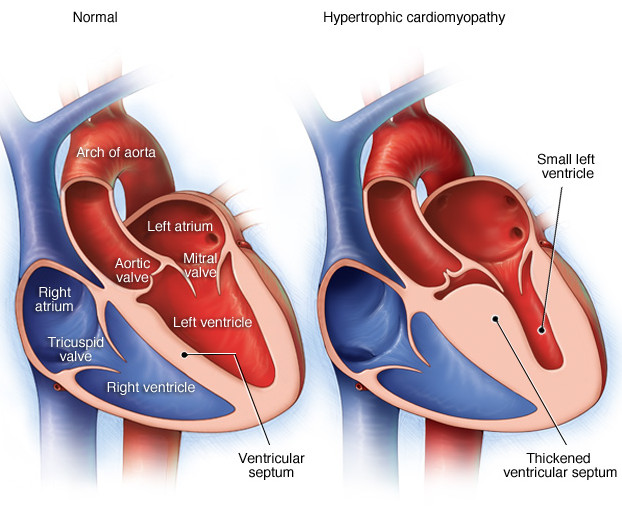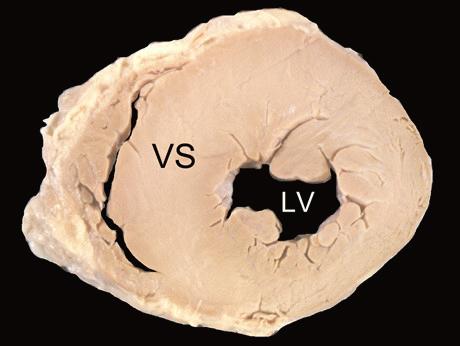Page Contents
OVERVIEW
This page is dedicated to organizing various examples of standardized exam questions whose topic is hypertrophic cardiomyopathy (HCOM/HCM). While this may seem a odd practice, it is useful to see multiple examples of how HCOM will be characterized on standardized exams (namely the boards and the shelf exams). This page is not meant to be used as a traditional question bank (as all of the answers will be the same), however seeing the classic “test” characterization for a topic is quite valuable.

KEY CHARACTERISTICS OF THIS CONDITION (ON EXAMS)
When it comes to standardized exams, each topic has its own “code” marked by key buzzwords, lab findings, clues, etc. If you are well versed in this code you will be able to more quickly identify the condition that is being discussed, and get the right answer on the exam you are taking. Below is the “code” for HCOM.
Chief Complaints:
- Syncope or sudden death: usually during exercise/physical exertion.
- Exertion related symptoms: such as angina or dyspnea
Patient History:
- Characteristic patient population: young patients (often times athletes or athletic in nature) are often the ones who are found to have this condition
- Family history of sudden death may be present (implying others in family with HCOM)
Clinical Workup:
- Characteristic systolic murmur:
- Crescendo-decresendo murmur
- Often heard best at left sternal border
- Decreasing pre-load increases intensity (standing, valsalva, etc increases the murmur’s intensity)
- Left ventricular hypertrophy can be seen on gross histology/echocardiogram (involves interventricular septum)
- Cardia myocyte hypertrophy can be seen histologically. The arrangement of myocytes will be disorganized and haphazard
QUESTION EXAMPLES
Question # 1
A 18 year old male suddenly collapses and dies while he is out jogging one morning. He has no remarkable past medical history other than an uncle who died abruptly at the age of 22. An autopsy is performed and reveals significant left ventricular hypertrophy that mainly affects the interventricular septum. No valvular abnormalities are present. What is the likely diagnosis in this patient?
Explanation # 1
Young patient + sudden syncope/death during exertion + left ventricular hypertrophy (involves interventricular septum) = HCOM
Question # 2
A 16 year old male suddenly collapses during a high school basketball game. Immediate resuscitation efforts are initiate d but are unsuccessful and the patient passes away. In the past the patient had complained of exertion related chest discomfort and shortness of breath. The patient has no other remarkable past medical history and had previously denied using alcohol, tobacco products, or any illicit drugs. What is the likely diagnosis?
Explanation # 2
Young patient + sudden syncope/death during exertion + symptoms of angina and dyspnea during exertion = HCOM
Question # 3
A 22 year old male goes to the clinic for evaluation after an episode of syncope. He was out running in the afternoon when he felt lightheaded and lost consciousness. The patient explains that he has had a couple of other episodes of feeling light headed during his runs in the past year but has has never “passed out” before. He is in good shape and has no other past medical history. He denies using tobacco products, alcohol, or any illegal drugs. He explains that his father died suddenly at the age of 32. A physical exam reveals the presence of a harsh systolic murmur. An echocardiogram is performed and reveals asymmetric interventiruclar septal hypertrophy favoring the left side. What is the likely diagnosis in this patient?
Explanation # 3
Young patient + sudden syncope/death during exertion + systolic murmur + left ventricular hypertrophy (involves interventricular septum) = HCOM
Question # 4
A 25 year old male comes to the clinic with complaints of chest discomfort that occur during exercise. He explains that the feeling stops about 5 minutes after he halts his activity. He also feels as though he is short of breath during these episodes. His past medical history is unremarkable. A family history includes a uncle who died abruptly at the age of 30 years. His vital signs are currently within normal limits. A cardiac exam reveals a crescendo-decresendo systemic murmur that becomes more pronounced when he stands up. What is the likely diagnosis in this patient?
Explanation # 4
Young patient + angina and dyspnea during exertion + crescendo-decresendo systemic murmur + murmur increased with decreased pre-load (standing up) = HCOM
Question # 5
A 25 year old female grad student collapses during a stressful examination and expires despite resuscitation efforts. She has no significant past medical history. An image representing her myocardial histology is shown below.

What is the likely diagnosis in this patient?
Explanation # 5
Young patient + sudden syncope/death during exertion + cardiac histology showing hypertrophied and disorganized myocytes = HCOM
Question # 6
A 22 year old male (with a known history of a harsh systolic murmur) dies suddenly. His father and uncle also died under similar circumstances during their early 30s. A gross autopsy of the specific isn shown below.

What is the likely diagnosis in this patient?
Explanation # 6
Young patient + sudden death + systolic murmur + left ventricular hypertrophy (involves interventricular septum) = HCOM
Question # 7
A 16 year old male comes to the ER because he recently had a syncopal episode after completing a 5K race. Currently he is awake and his vital signs are within normal limits. His lungs are clear to auscultation. A cardiac exam reveals a grade 3/6 systolic murmur that is heard best over the left sterna border. The murmur increases in intensity when the patient stands. What is the likely diagnosis in this patient?
Explanation # 7
Young patient + syncope during exertion + systolic murmur + murmur increased with decreased pre-load (standing up) = HCOM
Question # 8
A 34 year old male is borough to the ER after he loses consciousness when he is out for his daily jog. Currently his vitals are within normal limits. A grade 2/6 systolic murmur is best heard at the left sternal border. The intensity of the murmur increases when he stands up from a seated position. What is the likely diagnosis in this patient?
Explanation # 8
Young patient + syncope during exertion + systolic murmur + murmur increased with decreased pre-load (standing up) = HCOM
TESTABLE FACTS ABOUT THIS TOPIC (BEYOND ITS IDENTIFICATION)
Many questions on standardized exams go beyond simply recognizing the underlying topic. Often there are specific testable facts regarding some aspect of the topic’s pathophysiology/management/clinical implications that are commonly asked. Some of these are listed below:
Cause:
- Genetic mutation: in most cases caused by mutations in the genes coding for cardiac sarcomere proteins (such as components of the thick or thin filaments)
- Beta-myosin heavy chain mutations are most common
- Myosin-binding protein C mutations are common
- Inheritance: autosomal dominant with variable expression (in many cases)
Medications to avoid: anything that decreases ventricular preload should be avoided because it will increase flow obstruction. This includes medications that directly reduce venous return to the heart AND ones that lower systemic vascular resistance.
- Vasodilators: dihydropyridine calcium channel blockers, nitroglycerin, ACE inhibitors (all decrease systemic vascular resistance).
- Diuretics: will decrease blood delivery to the heart
Other:
- Cause of murmur: Left ventricular outflow obstruction between the mitral valve leaflet and the hypertrophied interventiruclar septum
Page Updated: 04.28.2017